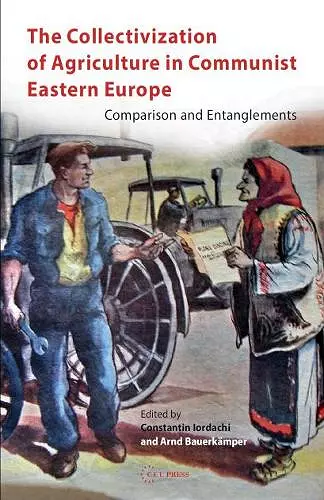The Collectivization of Agriculture in Communist Eastern Europe
Comparison and Entanglements
Constantin Iordachi editor Arnd Bauerkämper editor
Format:Hardback
Publisher:Central European University Press
Published:20th Feb '14
Currently unavailable, and unfortunately no date known when it will be back

This book explores the interrelated campaigns of agricultural collectivization in the USSR and in the communist dictatorships established in Soviet-dominated Eastern Europe. Despite the profound, long-term societal impact of collectivization, the subject has remained relatively underresearched. The volume combines detailed studies of collectivization in individual Eastern European states with issueoriented comparative perspectives at regional level. Based on novel primarysources, it proposes a reappraisal of the theoretical underpinnings and research agenda of studies on collectivization in Eastern Europe.The contributions provide up-to-date overviews of recent research in the field and promote new approaches to the topic, combining historical comparisons with studies of transnational transfers and entanglements.
"The volume helps to patch the hole in contemporary examinations of the change of systems that often overlook a legacy of rural transformation, and opens the way for additional anthropological and sociological studies. References and copious footnotes make for a comprehensive bibliography of the agrarian question under communism. Summing up: recommended." * Choice *
"The publication of The Collectivization of Agriculture in Communist Eastern Europe by two main editors, Constantin Iordachi and Arnd Bauerkämper, is the result of a highly ambitious project with clearly defined goals and methodology. While the collectivization of agriculture is a subject that has been under research in many Central and Eastern European countries, existing studies are written mostly just from the perspective of individual states and nations and most authors just aim at presenting a critical assessment of these countries' communist past. Methodological problems such as the social or environmental impact of collectivization thus tend to remain overshadowed by political history. Constantin Iordachi and Arnd Bauerkämper try to escape this stereotypical view of collectivization in Central and Eastern Europe and successfully." * Jahrbücher für Geschichte Osteuropas *
"Dans une perspective historiographique élargie et renouvelée, l’ouvrage entend « transcender le paradigme national » en étudiant le transfert d’un modèle collectiviste formé dans le contexte du projet stalinien et appliqué, deux décennies plus tard, à d’autres réalités politiques et sociales. Sous l’égide de l’histoire croisée, les auteurs veulent éclairer la complexité des interactions qui relient les diverses expériences nationales de transposition de la version soviétique du collectivisme en agriculture. Conduites selon des formes similaires de recours à la coercition économique, à la terreur politique, à la violence de la « dékoulakisation », les campagnes de collectivisation progressent selon un tempo qui varie d’un pays à l’autre. L’exploitation de nouveaux matériaux d’archives autorise l’établissement d’une chronologie plus fine de la préparation et de la mise en oeuvre des opérations, rythmées par des avancées accélérées, des reculs tactiques, puis des reprises plus soucieuses de pragmatisme. Le rappel de l’enchaînement des transformations – la réforme agraire de l’immédiat après-guerre, la nationalisation des biens fonciers, les étapes de la collectivisation – est sans aucun doute utile et pertinent. Ces données permettent de mieux appréhender les contextes politiques et institutionnels des phases d’accélération (1929-1935, 1945-1947, 1948-1965) et de répit (1935-1945, 1953-1956), et de cerner les raisons du succès et de l’échec des méthodes employées pour collectiviser des paysanneries majoritairement réticentes mais dont certaines composantes ont été manipulées au nom de la lutte des classes." * Revue d'histoire moderne & contemporaine *
ISBN: 9786155225635
Dimensions: unknown
Weight: 1210g
570 pages